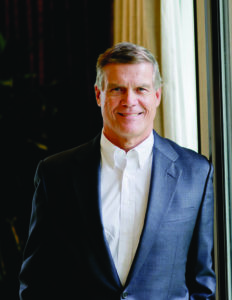Acquisitions, consolidation, game changing products—Vance Bell, chairman of Shaw Industries, has seen it all over the course of his storied career
 Setting the stage in the 1980s…
Setting the stage in the 1980s…
“Back in the early ‘80s, the go-to-market structure for carpet mills was distribution. But in 1981, Shaw pioneered a direct distribution model. There were two reasons for that. One, we saw that distributors controlled the go-to-market and obviously bought from several manufacturers. We felt we couldn’t get what we considered our fair representation and the share that we wanted to run our production capacity through distribution because they divided up the manufacturers and had their own model.
I noticed all these small retailers coming out of the woodwork during that period of time were starting to grow. And I wrote up a paper saying this really needs to be our focus. So we decided to launch that direct model where we hired our own sales force and started putting in regional distribution centers.”
Q&A
What was the result of this?
Through the ’80s, that was very successful. Shaw was growing two-to-three times more than anybody else in the industry. And it was putting pressure on a lot of the other carpet manufacturers. So there was going to be consolidation anyway during this period of time. In fact, we acquired Cabin Craft in November 1987. That whole thing was already building before Stainmaster. And I think that consolidation phase occurred because of the pressure we put on other manufacturers by taking so much share through that direct distribution model.
So direct distribution led to the idea that companies had to get more scale?
Not necessarily. It just led to the fact that other manufacturers couldn’t do it. They were losing position and saying, “OK, maybe it’s time to sell out.” And also in the ’80s, you had the corporate owners in the market—West Point Pepperell owned Cabin Craft; RCA owned Coronet for a long time; Armstrong owned E&B and other businesses besides floor covering. I think to some extent they all were saying, “We don’t want to stay in here. We need to get out over time.”
Then Stainmaster hit and what it did was pull the market leverage and the profitability and the branding back to the fiber producers. And it was basically Stainmaster; it had certain weights and certain price points. For the manufacturers, it turned Stainmaster into a commodity. There wasn’t a lot of profit in it for the manufacturers. That also spurred the consolidation phase. And if you look at that consolidation phase, we purchased Cabin Craft in November of 1987. We purchased E&B in December of ’89. We purchased Salem in 1992. At that same time, Mohasco, which had not yet acquired Aladdin, acquired Horizon Industries.
And the other offshoot of Stainmaster was the manufacturer saying, “I can’t make any money on Stainmaster; it’s just becoming a commodity. All the profits go to DuPont.” That spurred the manufacturers getting into backwards integration and putting in extrusion. The industry didn’t have the expertise and knowledge at the time, but we started doing it in 1991.
Was there anything special about Cabin Craft and E&B and Salem? Or was it just to get bigger?
They all had good names and positions, but it was really to acquire share. It was to consolidate the industry from a manufacturing level to allow us to have more leverage than we had either because of Stainmaster or because manufacturing in the early ’80s was very fragmented.
Every industry goes through consolidation. Like I said, when we came up with a different model (direct), it allowed us to take a lot of share and put pressure on the other manufacturers. But if it wasn’t that, it would have been something else. The industry was going to consolidate regardless.
We talk about DuPont and Stainmaster, but what about Monsanto and Allied. Did that really make a difference with their fibers?
Yeah, it made a difference in that they had a lot of profit in the branded fibers. And it set standards for the industry. Each one of them had certain specifications, certain weights, certain twist levels and certain price points. And those specifications forced all the manufacturers to compete; they had to offer an opening price point Stainmaster or an opening price point Wear-Dated. It made everybody compete on the same spec, and that just commoditized it. Again, all the profit was in the branded fibers.
Were those branded fibers better than the unbranded fiber that was out there?
No, it was just all marketing.
So the first sea change post 1986 was consolidation?
Certainly consolidation driven by both the Stainmaster launch and the change in distribution models and some of the corporates trying to get out.
Throughout the ’90s, how did the industry change aside from consolidation?
There was a softening due to a recession, but companies were starting to go into backwards integration. We were doing it, Aladdin was doing it in polypropylene.
Was that as a result of Stainmaster?
Yeah, I think it was a result of the people saying we needed to be in control of manufacturing. We needed to be in control of our own destiny and able to control our fiber supply and not be dictated by fiber brands that, for us, led to commoditization and less profit.
What else about the ’90s?
We bought Amoco…that’s 1992 or 1993. Obviously, another big thing was when Mohasco merged with Aladdin, and they had purchased Horizon 12-18 months before that. So, it put them on the level of over a billion dollars or a billion and a half dollars in carpet. And if the question was how the world changed in the 1990s, a big part of that was Shaw going into retail in December of 1995.
Let’s talk about that. It was 26 years ago. The dark ages. The simple question is, “Why?”
We started with the commercial contractor because of an assumed DuPont move into the contractor world, maybe trying to control them in some way. I’m not sure if that was absolutely true or not. But we responded to that. And that first one was Bell-Mann in Atlanta.
Obviously, for Shaw and the carpet and world during that time, that was a really big sea change, which frankly hurt us and helped other manufacturers grow.
Then it was residential. The first one was New York Carpet World. Then Carpetland USA. Overnight you ended up with 160 or so locations.
If you actually look at it, between late ’95 and ’97, between all of these different acquisitions and the startups of the stores Shaw built, I think we had almost 450 locations at the peak. But, obviously, that as not a good period of time for Shaw Industries. We were losing wholesale business. And this should have been understood—it was understood by some—that it was impossible to consolidate the retail piece as fragmented as it was.
Why did Shaw do it?
Damn if I know why.
You got all of that business back eventually. How did you do that?
We really never got it back. We started getting it back, and we developed what we called an aligned retail program, where we went out and got 1,400 or 1,500 retailers, and we’re basically paying a rebate. It was the start of rebates from the manufacturer level. We had to do it to bring some people back into the fold. But we really never recovered from it until we acquired Queen. That was really the recovery from retail
What was the reason for buying Queen?
We had gotten out of retail. We had been hurt in the market. And we just needed something to get our momentum back into our traditional business, which was carpet manufacturing, selling to retailers in the marketplace. And it was able to be worked out with Julian.
Queen also had a higher-end business, Tuftex, from California.
They had Tuftex, they had Sutton, the berber business, which was a really good business during that period of time.
Would you say Queen put you into the higher-end game?
Yeah. Queen definitely had some higher-end products. And, look, we’re all very close to Julian Saul. Julian is just a wonderful person. And he had very close relationships with a lot of retailers. That acquisition of Queen and having Julian come on board helped rebuild a lot of those relationships.
What could the industry have done better over the years?
Warranties got out of control. I think they’re confusing to the consumer and there’s a lot of holes and outs in those warranties. Manufacturers just try to continue upping each other on that. Also, the differentiation of product. Take base grade—it’s one spec and you have to meet that spec and everybody has it. That’s where a lot of volume is, but there’s not a lot of profitability. It gets into how the industry has not been able to differentiate product to brand and merchandise product effectively so that the dealer channel and end user understand the difference and why they should pay more for certain benefits and features. We just hadn’t done a good job with that.
What is the best decision you’ve made over the last 35 years.
Certainly over the last 15 years, I think it’s our decision to go all in on LVT early in the game. Even before the acquisition of USFloors, we were already pretty large and had made a lot of bets getting into resilient and LVT. I think we moved faster and more broadly than any other manufacturer. The acquisition of USFloors built on that.
What is the luckiest decision you’ve made.
When I first got into the industry, I was working for Cabin Craft and as a manufacturing trainee in their yarn mill in Newnan, Ga., which we subsequently acquired down the road. But I decided I wanted to get into sales. I came up here and interviewed with three companies. I interviewed with Bob Shaw. I interviewed with Cabin Craft. I interviewed with Rollins Jolly at Jolly Textiles. And I pretty much had offers for all three. And I took the one from Shaw primarily because my wife’s family at the time knew the Shaws. I had no idea which one to take. But if I had taken one of the other two, I wouldn’t be sitting here today.

